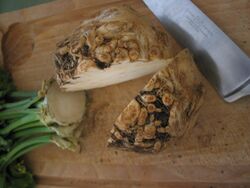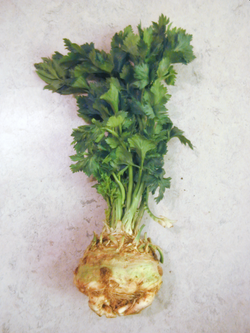Biology:Celeriac
| Celeriac | |
|---|---|
 A celeriac hypocotyl sliced in half, and with the greens removed | |
| Genus | Apium |
| Species | Apium graveolens |
| Cultivar group | Celeriac Group |
| Cultivar group members |
|
Celeriac (Apium graveolens var. rapaceum), also called celery root,[1] knob celery,[2] and turnip-rooted celery[3] (although it is not a close relative of the turnip), is a variety of celery cultivated for its edible stem or hypocotyl, and shoots. Celeriac is like a root vegetable except it has a bulbous hypocotyl with many small roots attached.
In the Mediterranean Basin and in Northern Europe, celeriac is widely cultivated.[4][3] It is also cultivated in North Africa, Siberia, Southwest Asia, and North America.[4][5] In North America, the 'Diamant' cultivar predominates.
History
Celeriac and celery originated in the Mediterranean Basin.[4] It was mentioned in the Iliad[6] and Odyssey[7][8] as selinon.[notes 1] Celeriac was grown as a medicinal crop in some early civilizations.[7][9] Celery contains a plant compound called apigenin, which was used in traditional Chinese medicine as an anti-inflammatory agent.[10]
Culinary use
Typically, celeriac is harvested when its hypocotyl is 10 to 14 centimetres (4 to 5 1⁄2 inches) in diameter.[5] However, a growing trend (specifically in South American cuisine, particularly Peruvian) is to use the immature vegetable, valued for its intensity of flavour and tenderness overall. It is edible raw or cooked, and tastes similar to the leaf stalks of common celery cultivars. Celeriac may be roasted, stewed, or blanched, and may be mashed. Sliced celeriac is used as an ingredient in soups, casseroles, and other savory dishes. The leaves (both the stalks and the blades) of the vegetable are quite flavoursome, and aesthetically delicate and vibrant, which has led to their use as a garnish in contemporary fine dining.[citation needed]
The shelf life of celeriac is approximately six to eight months if stored between 0 and 5 °C (32 and 41 °F), and not allowed to dry out.[11] However, the vegetable will tend to rot through the centre if the finer stems surrounding the base are left attached. If celeriac is not fresh its centre becomes hollow, though even when freshly harvested there can be a small medial hollow.[11] The freshness will also be obvious from the taste; the older it is, the weaker the celery flavour.[citation needed]
| Nutritional value per 100 g (3.5 oz) | |
|---|---|
| Energy | 176 kJ (42 kcal) |
9.2 g | |
| Sugars | 1.6 g |
| Dietary fiber | 1.8 g |
0.3 g | |
1.5 g | |
| Vitamins | Quantity %DV† |
| Thiamine (B1) | 4% 0.05 mg |
| Riboflavin (B2) | 5% 0.06 mg |
| Niacin (B3) | 5% 0.7 mg |
| Pantothenic acid (B5) | 7% 0.352 mg |
| Vitamin B6 | 13% 0.165 mg |
| Vitamin C | 10% 8 mg |
| Vitamin K | 39% 41 μg |
| Minerals | Quantity %DV† |
| Calcium | 4% 43 mg |
| Iron | 5% 0.7 mg |
| Magnesium | 6% 20 mg |
| Manganese | 8% 0.158 mg |
| Phosphorus | 16% 115 mg |
| Potassium | 6% 300 mg |
| Sodium | 7% 100 mg |
| Zinc | 3% 0.33 mg |
| Other constituents | Quantity |
| Water | 88 g |
| |
| †Percentages are roughly approximated using US recommendations for adults. Source: USDA Nutrient Database | |
See also
Explanatory notes
- ↑ Σέλινον has been translated by Lattimore as "the parsley that grows in wet places," by Murray as "parsley of the marsh," and by Butler as "wild celery."
References
- ↑ Watson, Molly. "All About Celery Root (Celeriac)". localfoods.about.com. http://localfoods.about.com/od/fall/tp/aboutceleryroot.htm.
- ↑ Zanteson, Lori (2019-11-07). "Health benefits of celery root may just surprise you" (in en). https://chicago.suntimes.com/2019/11/7/20921957/health-benefits-of-celery-root-recipe.
- ↑ 3.0 3.1 Chisholm, Hugh, ed (1911). "Celery". Encyclopædia Britannica. 5 (11th ed.). Cambridge University Press. p. 500.
- ↑ 4.0 4.1 4.2 Schuchert, Wolfgang. "Celeriac (Apium graveolens L. var. rapaceum)". Crop Exhibition. Max Planck Institute for Plant Breeding Research. http://www2.mpiz-koeln.mpg.de/pr/garten/schau/ApiumgraveolensLvarrapaceum/Celeriac.html.
- ↑ 5.0 5.1 "Celeriac (Apium graveolens rapaceum)". Growing Taste: A Home Food-Gardening Resource. https://growingtaste.com/vegetables/celeriac.shtml.
- ↑ The Iliad of Homer. 2.776.
- ↑ 7.0 7.1 Staub, Jack (2006-11-29). "The Vegetable World's Ugly Duckling: Celeriac" (in en). NPR. https://www.npr.org/templates/story/story.php?storyId=6551175.
- ↑ "eat celery root". eattheseasons.com. 2010. http://www.eattheseasons.com/Archive/celery_root.htm.
- ↑ Farooqi, A. A.; Kathiresan, C.; Srinivasappa, K. N. (2006-01-01), Peter, K. V., ed., "17 – Celeriac" (in en), Handbook of Herbs and Spices, Woodhead Publishing Series in Food Science, Technology and Nutrition (Woodhead Publishing): pp. 313–316, ISBN 978-1-84569-017-5, https://www.sciencedirect.com/science/article/pii/B9781845690175500178, retrieved 2022-07-09
- ↑ "Celery: Health benefits, nutrition, diet, and risks" (in en). 2019-12-04. https://www.medicalnewstoday.com/articles/270678.
- ↑ 11.0 11.1 "Small-scale postharvest handling practices – A manual for horticultural crops – 3rd edition". FAO Agriculture and Consumer protection. March 1995. http://www.fao.org/wairdocs/x5403e/x5403e09.htm.
External links
- Nutritional Summary for Celeriac , cooked, boiled, drained, without salt
- "RHS Award of Garden Merit: Asparagus, Celeriac , chard, Chinese cabbage, fennel, melon, pak choi, rhubarb 2011". http://www.rhs.org.uk/Plants/Plant-trials-and-awards/Plant-awards/AGM-fruit-and-veg/AGM-asparagus_chard_pak_rhubarb_melon. (306 KB)
Wikidata ☰ Q575174 entry
de:Echter Sellerie#Knollensellerie it:Sedano rapa
 |


